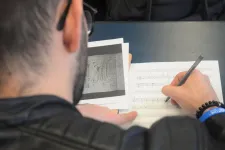INFORMATION:
In addition to USAMRIID, other institutions participating in the study were Adimab, LLC; Albert Einstein College of Medicine, Bronx, New York; Mapp Biopharmaceutical, Inc.; the University of Texas Medical Branch at Galveston; the University of Texas at Austin; Institut Pasteur in Paris, France; Ben-Gurion University of the Negev in Beer-Sheva, Israel; and Uganda Virus Research Institute in Entebbe, Uganda.
About the U.S. Army Medical Research Institute of Infectious Diseases:
For over 50 years, USAMRIID has provided leading edge medical capabilities to deter and defend against current and emerging biological threat agents. The Institute is the only laboratory in the Department of Defense equipped to safely study highly hazardous viruses requiring maximum containment at Biosafety Level 4. Research conducted at USAMRIID leads to medical solutions - vaccines, drugs, diagnostics, information, and training programs - that benefit both military personnel and civilians. Established in 1969, the Institute plays a key role as the lead military medical research laboratory for the Defense Threat Reduction Agency's Joint Science and Technology Office for Chemical and Biological Defense. USAMRIID is a subordinate laboratory of the U.S. Army Medical Research and Development Command. For more information, visit http://www.usamriid.army.mil.
Reference:
Chandran, Kartik et al. "Protective neutralizing antibodies from human survivors of Crimean-Congo hemorrhagic fever." DOI: 10.1016/j.cell.2021.05.001
https://www.cell.com/cell/fulltext/S0092-8674(21)00584-5\
Authors:
J. Maximilian Fels, Daniel P. Maurer, Andrew S. Herbert, Ariel S. Wirchnianski, Olivia
Vergnolle, Robert W. Cross, Dafna M. Abelson, Crystal L. Moyer, Akaash K. Mishra,
Jennifer T. Aguilan, Ana I. Kuehne, Noel T. Pauli, Russell R. Bakken, Elisabeth K.
Nyakatura, Jan Hellert, Gregory Quevedo, Leslie Lobel, Stephen Balinandi, Julius J.
Lutwama, Larry Zeitlin, Thomas W. Geisbert, Felix A. Rey, Simone Sidoli, Jason S.
McLellan, Jonathan R. Lai, Zachary A. Bornholdt, John M. Dye, Laura M. Walker, and Kartik Chandran.
Funding:
This work was supported in part by a National Institutes of Health grant to the Prometheus Center for Excellence in Translational Research, a consortium of academic, industry, and government partners working to develop antibody-based therapies against CCHFV and other highly lethal viruses. A complete list of funding organizations appears in the publication.
Scientists develop novel therapy for crimean-congo hemorrhagic fever virus
2021-06-01
(Press-News.org) Army scientists working as part of an international consortium have developed and tested an antibody-based therapy to treat Crimean-Congo hemorrhagic fever virus (CCHFV), which is carried by ticks and kills up to 60 percent of those infected. Their results are published online today in the journal Cell.
Using blood samples donated by disease survivors, the study's authors characterized the human immune response to natural CCHFV infection. They were able to identify several potent neutralizing antibodies that target the viral glycoprotein--a component of the virus that plays a key role in disease development. Several of these antibodies, administered individually or in combination, protected mice from CCHFV when given prior to virus exposure.
To treat mice that had already been infected, the team created "bispecific" antibodies that combined potency with the ability to bind to two separate sites on the CCHFV glycoprotein. One of these bispecific antibodies, called DVD-121-801, overcame CCHFV infection in mice with just a single dose administered 24 hours after challenge with live virus.
Efforts are underway to develop DVD-121-801 as a potential therapeutic for human patients, according to co-first author Andrew H. Herbert, Ph.D., of the U.S. Army Medical Research Institute of Infectious Diseases (USAMRIID).
CCHFV is the most prevalent tick-borne virus that causes human disease, and is endemic in countries across Europe, Asia, and Africa. Despite its high lethality and widespread distribution, no vaccines or specific treatments are available. It has been designated a priority pathogen by the World Health Organization.
"Rodent models of CCHFV infection are useful in testing and down-selecting neutralizing antibodies," commented Herbert. "However, to advance a lead candidate for therapeutic use, it will be necessary to conduct studies in larger animal models that more faithfully recapitulate human disease."
ELSE PRESS RELEASES FROM THIS DATE:
New evidence may change timeline for when people first arrived in North America
2021-06-01
AMES, Iowa - An unexpected discovery by an Iowa State University researcher suggests that the first humans may have arrived in North America more than 30,000 years ago - nearly 20,000 years earlier than originally thought.
Andrew Somerville, an assistant professor of anthropology in world languages and cultures, says he and his colleagues made the discovery while studying the origins of agriculture in the Tehuacan Valley in Mexico. As part of that work, they wanted to establish a date for the earliest human occupation of the Coxcatlan Cave in the valley, so they obtained radiocarbon dates for several rabbit and deer bones that were collected from the cave in the 1960s as part of the Tehuacan Archaeological-Botanical Project. The dates for the bones suddenly ...
Innovative surgical simulator is a significant advance in training trauma teams
2021-06-01
Key takeaways
The surgical simulator can realistically simulate multiple trauma scenarios at once, compared with traditional simulators that can only simulate one or a limited number of conditions.
Trauma team members who tested the simulator preferred it for its realism, physiologic responses, and feedback.
The benefits of this innovative simulator may be able to extend to other surgical procedures and settings.
CHICAGO (June 1, 2021): Simulators have long been used for training surgeons and surgical teams, but traditional simulator platforms typically have a built-in limitation: they often simulate one or a limited ...
New method to improve durability of nano-electronic components, further semiconductor manufacturing
2021-06-01
University of South Florida researchers recently developed a novel approach to mitigating electromigration in nanoscale electronic interconnects that are ubiquitous in state-of-the-art integrated circuits. This was achieved by coating copper metal interconnects with hexagonal boron nitride (hBN), an atomically-thin insulating two-dimensional (2D) material that shares a similar structure as the "wonder material" graphene.
Electromigration is the phenomenon in which an electrical current passing through a conductor causes the atomic-scale erosion of the material, eventually resulting in device failure. Conventional semiconductor technology addresses this challenge by using a barrier or liner material, but this takes up precious space on the wafer that could otherwise be used to pack in ...
Forged books of seventeenth-century music discovered in Venetian library
2021-06-01
UNIVERSITY PARK, Pa. -- In 1916 and 1917, a musician and book dealer named Giovanni Concina sold three ornately decorated seventeenth-century songbooks to a library in Venice, Italy. Now, more than 100 years later, a musicologist at Penn State has discovered that the manuscripts are fakes, meticulously crafted to appear old but actually fabricated just prior to their sale to the library. The manuscripts are rare among music forgeries in that the songs are authentic, but the books are counterfeit.
Uncovering deception was not what Marica Tacconi, professor of musicology and associate ...
Time-dependent viral interference between influenza virus and coronavirus in the infection of differ
2021-06-01
A new study carried out in pig cells suggests previous infection with swine influenza virus (SIV) can protect against the development of porcine respiratory coronavirus (PRCoV) if there is a zero- or three-day interval between infections.
The findings, published in the peer-reviewed journal Virulence, may also be relevant to influenza and coronavirus infection in humans.
Ju-Yi Peng of the University of Veterinary Medicine Hannover and colleagues used air liquid interface cultures of cells taken from pigs' windpipes to investigate the interactions between the two viruses.
They found that prior infection by swine influenza virus completely inhibited coronavirus infection when the cells were infected ...
Analysis reveals global 'hot spots' where new coronaviruses may emerge
2021-06-01
Berkeley -- Global land-use changes -- including forest fragmentation, agricultural expansion and concentrated livestock production -- are creating "hot spots" favorable for bats that carry coronaviruses and where conditions are ripe for the diseases to jump from bats to humans, finds an analysis published this week by researchers at the University of California, Berkeley, the Politecnico di Milano (Polytechnic University of Milan) and Massey University of New Zealand.
While the exact origins of the SARS-CoV-2 virus remain unclear, scientists believe that the disease likely emerged when a virus that infects horseshoe bats was able to jump to humans, either ...
Diet plays critical role in NASH progressing to liver cancer in mouse model
2021-06-01
Non-alcoholic fatty liver disease (NAFLD) is the most common cause of chronic liver disease worldwide. NAFLD patients are at higher risk of developing Non-alcoholic steatohepatitis (NASH), which causes severe and chronic liver inflammation, fibrosis and liver damage. A patient with NASH is believed to be at high risk for developing a form of liver cancer called hepatocellular carcinoma (HCC).
Apart from lifestyle interventions, there are currently no approved treatments for NASH. A liver transplant is sometimes the only remedy.
While risk factors for NASH (obesity, type-2 diabetes and gene mutations like PNPLA3) and HCC ...
Researchers discover gene linked to bone cancer in children, ID potential novel therapy
2021-06-01
CHAPEL HILL, North Carolina--Researchers have discovered a gene, OTUD7A, that impacts the development of Ewing sarcoma, a bone cancer that occurs mainly in children. They have also identified a compound that shows potential to block OTUD7A protein activity. The finding, by scientists at the University of North Carolina and the Lineberger Comprehensive Cancer Center, appeared online June 1, 2021, in Advanced Science.
About 250 children and young adults are diagnosed with Ewing sarcoma each year in the U.S. About half of those diagnosed will ultimately succumb to the disease, pointing to the need for better therapies.
"Our primary research focus targeted the EWS-FLI1 fusion protein found in about 85 percent of Ewing sarcoma patients," said UNC Lineberger's ...
SWOG researchers advance cancer care at virtual ASCO 2021
2021-06-01
"SWOG always brings an impressive portfolio of work to the ASCO annual meeting," said SWOG Chair Charles D. Blanke, MD, "and this year I'm particularly excited about the research our investigators are presenting because it includes results that are likely to be practice-changing."
Investigators will present 12 abstracts from SWOG-led or co-led studies and 11 abstracts from studies led by other groups within the National Clinical Trials Network (NCTN).
Results from S1216 will be presented orally by study chair Neeraj Agarwal, MD, of the Huntsman Cancer Institute at the University of Utah. S1216 compared androgen deprivation therapy (ADT) combined with TAK-700 to the standard ...
UArizona engineers demonstrate a quantum advantage
2021-06-01
Quantum computing and quantum sensing have the potential to be vastly more powerful than their classical counterparts. Not only could a fully realized quantum computer take just seconds to solve equations that would take a classical computer thousands of years, but it could have incalculable impacts on areas ranging from biomedical imaging to autonomous driving.
However, the technology isn't quite there yet.
In fact, despite widespread theories about the far-reaching impact of quantum technologies, very few researchers have been able to demonstrate, using the technology available now, that quantum methods have an advantage over their classical counterparts.
In a paper published on June 1 in the journal Physical Review X, University of Arizona researchers experimentally ...




